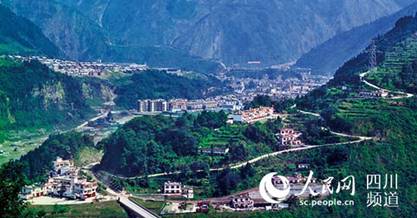


Yingxiu Town in Wenchuan County takes on a new look. (Photo via the Publicity Department of CPC Wenchuan County Committee)
The leadership of the Communist Party of China (CPC) is the fundamental cause of the post-disaster reconstruction miracle in Wenchuan County, the location of epicenter of the magnitude 8 earthquake that struck southwest China’s Sichuan Province on May 12, 2008.
As the most destructive earthquake that hit China since the founding of the People’s Republic of China, the Wenchuan Earthquake affected many Chinese provinces, with the combined area of the affected cities being equivalent to the total area of the territory of Spain and the affected population exceeding the total population of the five Nordic countries.
Even so, within three years after the disaster, Wenchuan County restored its strength and started to inject impetus into economic and social development again, creating a post-disaster reconstruction miracle that amazed the world.
“The most solid buildings are schools, the most beautiful buildings are people’s houses, the most modern buildings are hospitals, and the ones that benefited the most from the reconstruction are local people.” This kind of commentary regarding the post-disaster reconstruction in Wenchuan is widely shared among the local people.
From disaster relief to restoration and reconstruction, there have been a host of miscellaneous problems solved, and a multitude of appeals addressed, with every issue being a test of the governing capacity of the CPC.
The CPC Central Committee issued a series of instructions immediately after the occurrence of the disaster, calling for general mobilization, launching the levelⅠemergency response plan, mobilizing troops from military commands across the country, and pooling resources of the whole country to help the affected areas.
27 days after the disaster, China’s State Council issued the regulations on post-Wenchuan Earthquake restoration and reconstruction. Then four months after the disaster, China published a master plan on post-disaster reconstruction, and set the general goal of realizing basic restoration and reconstruction in three years, revitalizing the affected areas in five years while securing a moderately prosperous life in all respects in 10 years.
During the year after the Wenchuan Earthquake, over 1.2 million members of the CPC committee at various levels in Sichuan Province formed more than 20,000 teams to provide various services for the affected areas and people, helping restore production and to rebuild homes in the quake-stricken areas.
Thanks to all these efforts, over 15 million people had already started their new lives in emergency resettlement sites within 10 days after the disaster, while the transitional resettlement of 12 million people was completed 100 days after the disaster, and 3.5 million families saw their damaged houses repaired and reinforced within a year after the disaster.
Other than this, the reconstruction of the houses of 1.5 million rural families was completed in one year and a half after the disaster, while 250,000 urban citizens got houses to live in within 2 years after the disaster, which means China achieved its goal of solving the housing problem of every affected family a year in advance.
“One province provides assistance for one severely-affected county. Pool the strength of the whole country to accelerate the restoration and reconstruction in the quake impacted areas.” The scientific decision was proven to be the best innovation in the post-disaster reconstruction efforts.
Nearly two thirds of Chinese provinces responded to the call and took part in the targeted-assistance campaign, which has later evolved into targeted cooperation naturally.
Moreover, in the first three years after the Wenchuan Earthquake, the central government spent as much as 220 billion yuan (about $30.9 billion) on the restoration and reconstruction of the affected areas, and provided strong institutional support for the efforts with a series of master plans covering such aspects as tax and fee cuts, financial assistance, land utilization, and legal support.
 Fire brigade in Shanghai holds group wedding
Fire brigade in Shanghai holds group wedding Tourists enjoy ice sculptures in Datan Town, north China
Tourists enjoy ice sculptures in Datan Town, north China Sunset scenery of Dayan Pagoda in Xi'an
Sunset scenery of Dayan Pagoda in Xi'an Tourists have fun at scenic spot in Nanlong Town, NW China
Tourists have fun at scenic spot in Nanlong Town, NW China Harbin attracts tourists by making best use of ice in winter
Harbin attracts tourists by making best use of ice in winter In pics: FIS Alpine Ski Women's World Cup Slalom
In pics: FIS Alpine Ski Women's World Cup Slalom Black-necked cranes rest at reservoir in Lhunzhub County, Lhasa
Black-necked cranes rest at reservoir in Lhunzhub County, Lhasa China's FAST telescope will be available to foreign scientists in April
China's FAST telescope will be available to foreign scientists in April "She power" plays indispensable role in poverty alleviation
"She power" plays indispensable role in poverty alleviation Top 10 world news events of People's Daily in 2020
Top 10 world news events of People's Daily in 2020 Top 10 China news events of People's Daily in 2020
Top 10 China news events of People's Daily in 2020 Top 10 media buzzwords of 2020
Top 10 media buzzwords of 2020 Year-ender:10 major tourism stories of 2020
Year-ender:10 major tourism stories of 2020 No interference in Venezuelan issues
No interference in Venezuelan issues
 Biz prepares for trade spat
Biz prepares for trade spat
 Broadcasting Continent
Broadcasting Continent Australia wins Chinese CEOs as US loses
Australia wins Chinese CEOs as US loses